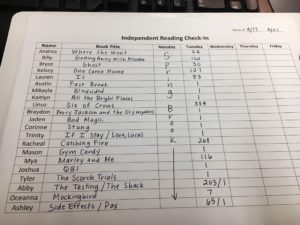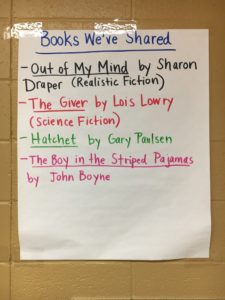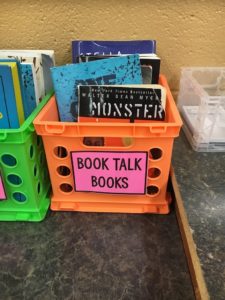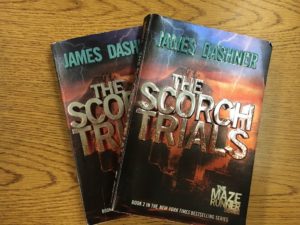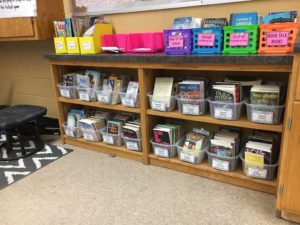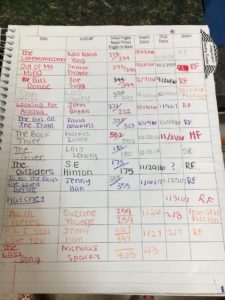Dr. Seuss once wrote, “The more that you read, the more things you will know. The more that you learn, the more places you’ll go.” As teachers, our hearts pitter-patter when we hear this phrase because we know it’s true. Students who are “true readers” tend to exhibit some or all of the following generalizations in our middle school classrooms:
1. Strong, unique writing skills
2. Higher academic vocabulary
3. Faster and higher comprehension of nonfiction content reading
4. More creative
5. Can think within, beyond, and about the fiction books read and discussed in class
6. Can share their thinking about reading with partners, small groups, and the whole class
7. Brings a plethora of ideas when it comes to a new project, task, or assignment
8. Scores average or above average on state and district testing
9. Not likely to be a behavior issue in class
10. Responds thoughtfully to written reading responses
Being a language arts teacher and literacy coach, it has been my honest observation that students who like to read and are constantly devouring books show qualities from the list above. So of course this brings up the question, “How can we get middle school students reading more?” We know that knowledge is power, but let’s face it: it’s not enough. Just because someone knows doing something will create a desirable result, it doesn’t mean that person is going to do it. If life were that simple, everyone would change their choices and lifestyles to get the results they desired.
What if I told you though that I have specific methods you could use in your middle school classroom that would increase the reading quantity your students read this school year? My hope is that at least one of these strategies resonates with you and that you’re able to try it out. By trying these strategies, I’m not promising that every student in your class will love reading. I do promise you, however, that with an increased volume of reading, many of your students will shift their attitude about reading (at least slightly). This, in turn, will create students who are true readers.
Strategy One: Independent Reading Check-In
Before giving students time for independent reading, take time to ask students what they’re reading and the page number they’re on in their current independent reading book with this independent reading tracker. This strategy is quite simple to set-up and execute, and it has several benefits. First of all, by asking students to publicly state in front of the class what they’re reading and what page they’re on, we are assuming they have a book. One of the most frustrating things for teachers is when students don’t bring a book to read to Language Arts class, where they know they will have time to read each day. Assuming the best in students is a good thing, and most will bring a book every day for the simple reason that they know you are going to ask them.
This is also a great time to identify students you need to check in with for a reading conference. Who is starting a new book every few days and continuously abandoning books? Who is making snail-paced progress in his/her IR books and needs a push or a book with an easier reading level or more familiar content? Who is flying through books so fast you want him/her to pause and check-in with where his/her comprehension is at? Who never seems to be able to find a book to read? Who always reads out of the same genre and never mixes it up?
Keeping these check-ins in your reading conference binder provides kick-off points for reading conferences based on students’ actual reading habits. The daily check-in also does something else unexpected: it helps create a community of readers in your classroom. Students hear the books other students are reading and hear their daily reading progress. This opens doors to initiate conversations about reading. You might hear students say things like, “I just read that same book? I was thinking about reading that book, too. What do you think about it?”
Strategy Two: Interactive Read Aloud
Make the “Books We’ve Shared” one of the first anchor charts you create at the beginning of the school year. As the school year goes on, continue to add the books you’ve read aloud to your class on the anchor chart. We can’t make kids read, but when we do a daily interactive read aloud, students really don’t have a choice but to sit back, listen, and engage. Being read out loud to is one of the most enjoyable educational experiences we can gift to students of any age. For middle school students, they are guaranteed to finish several books across the school year simply through interactive read aloud. These books often spark an interest in a particular author, series, topic, or genre that lead to increased independent reading.
Some key tips for reading out loud to middle school students include:
1. Select a variety of genres across the school year. What you choose to read out loud could be short stories, newspaper articles, entire novels, etc.
2. Make the reading interactive without “killing” the reading. Do this by setting aside 10-15 minutes to read out loud to your students. Within that 10-15 minutes, pick 2-3 stopping points where you will give students the chance to respond to a question, turn and talk about a specific topic from the book, respond to prompt about the book in a sketch or quick writing response, etc. Take 2-3 minutes after the reading is over to have students discuss 2-3 debrief questions.
3. Allow students to listen and respond during the interactive read aloud. They do not need a copy of the text during the read aloud. This defeats the purpose for this context of reading instruction.
4. To make interactive read aloud “worth it” in the tight time constraints many middle school language arts teachers face, you must strategically intertwine IRA into other instructional contexts. Your IRA text can be where you get a sentence for a grammar activity, a common text you use to model your thinking about a reading minilesson, where you teach vocabulary from, and a mentor text for writing instruction.
5. Use the IRA for writing about reading responses so that you’re able to check students’ reading comprehension through a common text.
Strategy Three: Book Talks
Start out the school year by making it your goal to give a 2-3 minute book talk at the beginning of Reading Workshop every single day. Use books from your classroom library to highlight this as a resource and have a place where students can easily access the books that have been highlighted. Make books talks informal and quick. Once you feel like students understand what is involved in giving a book talk, ask for student volunteers to sign up on a blank monthly calendar to give a book talk. Don’t have any rules around it. Allow students to sign up multiple times and don’t make students sign up if they don’t want to. By putting in this process without formalizing it into a big book talk project, books talks will add to the reading atmosphere in your classroom and get students interested in new reading material.
Strategy Four: Small Group Reading Instruction
In my opinion, basing reading instruction only on class novels or only on independent reading just isn’t enough. Teachers need to know their students deeply as readers in order to help them become better readers. This happens at the small group table, not when lecturing to the whole class. Guided Reading and Literature Circles should be part of every middle school language arts classroom. Guided Reading is homogeneous groupings of students reading a common book at their reading level. The groups meet once-two times a week with the teacher, and the discussion and teaching around the book is driven by the teacher. Literature Circles are heterogeneous groupings of students reading grade level texts and coming together to discuss these texts. Students reading books above their reading level can listen to an audio version of the book. The main point of literature circles is to get students discussing grade-level texts with one another. This discussion is driven by the students.
Once I establish all the instructional contexts of Reading Workshop through a Reading Workshop Kick-off at the beginning of the school year, I continue holding a daily Reading Workshop where during the application time of the minilesson I meet with a small reading group. I meet with one group a day so that I’m able to see every student every week. I alternate between a round of Guided Reading (one novel or NF text for each group spread across 3-4 weeks) and a round of Literature Circles (one novel or NF text for each group spread across 3-4 weeks) back and forth across the remainder of the school year. By the end of the school year, students generally have participated in 3 “rounds” of Guided Reading and 3 “rounds” of Literature Circles increasing their reading quantity by 6 books a school year.
Strategy Five: Give Time to Read
We cannot depend on students’ independent reading to happen at home. We just simply cannot. If you want your students to read more, but you never give your students any time to read, then you are off base. Human beings show what they value by where they give their time. You can preach all day long to students about the importance of reading, but until your actions match your words, they are just words. Give students time to get lost and hooked into a book. The students who “hate” to read surprisingly seem to like it (at least a little) once they give it a try. Use independent reading (minilesson application) time to hold reading conferences, lead Guided Reading groups, and observe Literature Circle groups.
Strategy Six: Partner/Trio Sets of Books
Two years ago, I had three students in my class that enjoyed reading the same book at the same time for their independent reading material. Our school librarian and I were constantly helping them find three of the same book so they could do this. They would make a reading plan and discuss their reading whenever they could find the time. It was truly a beautiful thing. Last year, I took a cue from these students and ordered doubles of popular books in my classroom library. I then encouraged students to pick a book to independently read at the same time as a classmate was reading it. Students LOVED this. I witnessed actual, unprompted conversations between students reading the same book before and after class, during morning duty, by their lockers after school, etc. Middle school students are social, and making reading social is just another way to hook them into loving it.
Strategy Seven: Make your Classroom Library Accessible and User-Friendly
Forget about reading level when organizing your classroom library. Reading levels and lexile scores are a tool teachers can use to provide their best instruction during Guided Reading. When organizing your classroom library, organize books by genre, author, and/or topic so that students can grab a tub of books they’re interested in and look through them quickly. I would also resist the urge of a classroom library organized like the school or public library (by call number, alphabetized by title, etc.). The bins create a quick and easy way for students to identify what they’re looking for and find it without feeling overwhelmed, intimidated, or making an excuse of they don’t know where to look.
Strategy Eight: Give Time for Students to Decide What to Read
I don’t know about you, but when I choose a book that I want to read for my own independent reading enjoyment, I want it to be worth my while. I spend time researching, looking at ratings, looking at books by an author or a topic I’ve enjoyed in the past, etc. If we like to do these things for ourselves, what a great thing to teach and give time for our students to do, too. In my students’ Reader’s Notebooks, there is a page titled, “Books I Want to Read” for students to write down books that have interested them from book talks, social media, conversations they’ve had with other students, etc.
At my school, we have a monthly “Rec Reading” time where students get to go down to the LMC and check-out new books. Our library is open all of the time for students, but this is a set time that we go down there as a language arts class. Before this time each month, I like to give students about 10 minutes of class time to discuss with friends books they want to read next, give an open forum for whole-class book talks, and also let students go on computers to explore websites like What Should I Read Next? and Goodreads.
Strategy Nine: Document Reading
Have students keep a reading log across the year of the books they’ve read. Students can document books they’re finished, books they’ve abandoned, the genre of the books they’ve read, how long it took them to read each book, etc. I have my students put all of the books they’ve read across the school year in their reading log, including books we read as a class during IRA and books they read in small group reading instruction. When I hold reading conferences with students, I like to take a peak at their reading log to help discuss their reading habits with them. Students also use their reading logs to access their progress toward reading goals we create.
***
So there it is! Nine strategies to get your middle school students to up their reading quantity this school year. If you try any of these strategies out, make sure you venture back here and let me know! Good luck!




